a Life Design work approach
This is a primary TLN brainscape © and brainroad ©. A brainscape © is a mental landscape. A brainroad © is an exploration path. There is a great deal of flexibility in these terms.
When you grow up you tend to get told that the world is the way it is and your life is to just live your life inside the world … try not to bash into the walls too much … try to have a nice family life … have fun … save a little money. That's a very limited life. Life can be much broader. Once you discover one simple fact: every thing around you that you call life was made up by people who are no smarter than you. And you can change it … You can influence it. You can build you own things that other people can use. Once you learn that you will never be the same again … … The minute you understand you can poke life and actually something … if you push it something will pop out the other side. You can change it, you can mold it. That's the most important thing. — Steve Jobs
You won't find many answers here. Just a work approach.
It is up to you to design your way forward in time — both in age and calendar years (2020, 2030 …).
The amount of time you invest is an indication of the value that you place on YOUR life — something beyond being just another cog in somebody else's system.
Things won't work out the way you think — you have to be prepared for this reality. (calendarize this?)
You can't foretell the future from the past or present. (calendarize this?)
Why not think of your life as an adventure rather than just routines.
This page and its topics are attention redirecting tools !!!
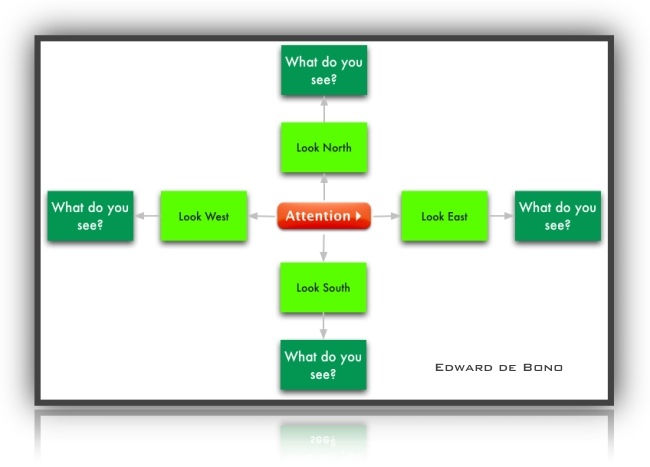
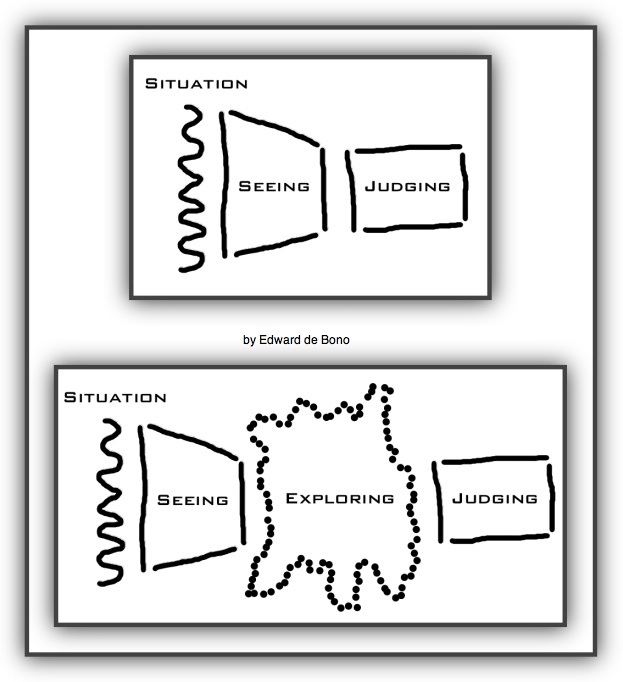
Why We Need New Thinking About Thinking
A person stands before a picture and says: 'I like it' or 'I don't like it.'
After a course on art appreciation that same person stands before a picture but now has a handful of attention directing tools:
… look at the composition;
… look at the choice of colours;
… look at the use of light and shade;
… look at the brush work;
… look at the way the clothing is treated;
… look at the background;
… look at the background figures.
After a time this richer attention scan becomes automatic.
In addition there are things that will now be noticed that may indicate a period of painting or a particular painter or a particular period of a particular painting (Picasso late period, Warhol early period).
We cannot see things unless we are prepared to see them.
That is why science advances by fits and starts as paradigms change and we are allowed to see things differently (I shall return to this point later—but not here).
That is why the analysis of data can never produce all the ideas present in that data.
That is why analysis is a limited tool, not the complete one we have always believed it to be (I shall also return to this point later—but not here).
The James Gleick book on Chaos: Making a New Science shows how the pioneers in this field went back to look at old data but to look at it with new perceptions and could now see new things. shows how the pioneers in this field went back to look at old data but to look at it with new perceptions and could now see new things.
Edward de Bono
The foundation for a "healthy" life design is a healthy work life
I'm not talking about your job or what you think a career is—see Managing Oneself. A work life is broader, different, longer …
Initially life design and managing oneself could be worked on (calendarized) in parallel. Both should have about five or more years of "foundation" work (B.C. Forbes quotes below).
Both life design and managing oneself are tools for reducing the number of optional uses of time—they set directions.
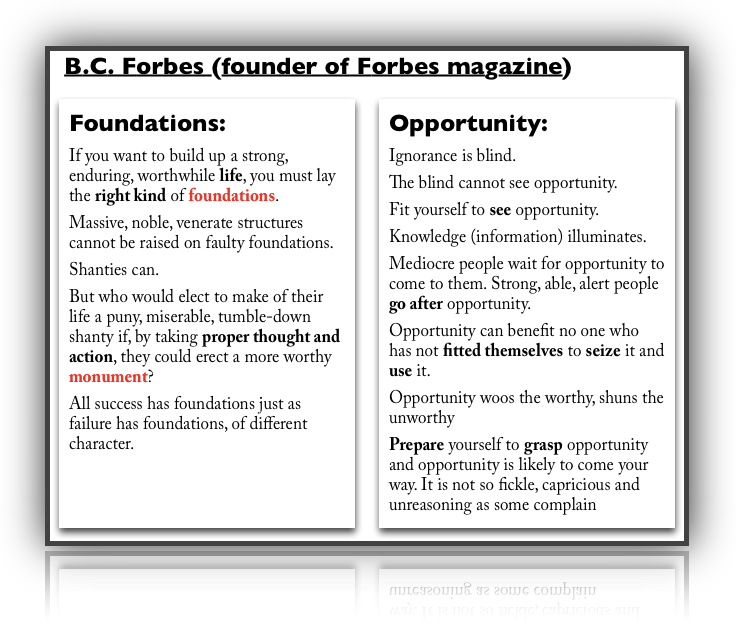
The society of organizations demands of the individual decisions regarding himself.
At first sight, the decision may appear only to concern career and livelihood.
“What shall I do?” is the form in which the question is usually asked.
But actually it reflects a demand that the individual take responsibility for society and its institutions.
“What cause do I want to serve?” is implied.
 The World is Full of Options The World is Full of Options
 Carefully choosing your nonprofit affiliations (beware of scams and inside-out bureaucracies because society suffers the consequences and you are part of society. Carefully choosing your nonprofit affiliations (beware of scams and inside-out bureaucracies because society suffers the consequences and you are part of society.
If they don’t produce the desired results outside of themselves then we have to pay a second or a third or a fourth … organization until we get what is needed.)
And underlying this question is the demand the individual take responsibility for himself.
 Managing Oneself then … Managing Oneself then …
 The Effective Executive: Preface The Effective Executive: Preface
“What shall I do with myself?” rather than “’What shall I do?” is really being asked of the young by the multitude of choices around them.
The society of organizations forces the individual to ask of himself:
 “Who am I?” “Who am I?”
 “What do I want to be?” “What do I want to be?”
 “What do I want to put into life and what do I want to get out of it?” “What do I want to put into life and what do I want to get out of it?”
read more on how can the individual survive …
The Age of Discontinuity:
Guidelines To Our Changing Society
enhanced by bobembry
... replace the quest for success with the quest for contribution.
(to the society of organizations moving in time — above)
The critical question is not, “How can I achieve?”
but “What can I contribute?”
The Daily Drucker
You can’t design your life around a temporary organization
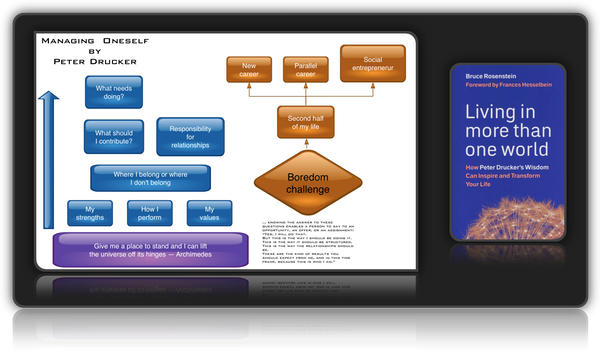
Successful careers are not planned
They develop when people are prepared
for opportunities
because they know
their strengths,
their method of work, and
their values.
Knowing where one belongs
can transform an ordinary person
—hardworking and competent but otherwise mediocre—
into an outstanding performer.
Larger
Managing Oneself and Living in More than One World
To get the benefits you have to calendarize these
“What do you need to learn to get the most out of your strengths?”
The World is Full of Options
“What do you need to learn so that you can decide where to go next?”
Managing in a Time of Great Change
The three types of intelligence discussed in The Prince by Niccolò Machiavelli
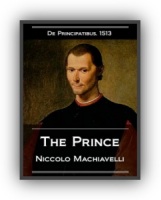
Types of behavior that can be observed …
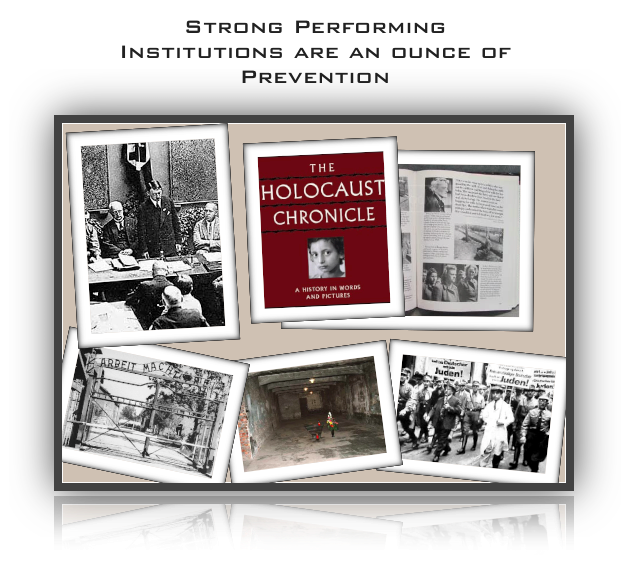
… “Power has to be used.
It is a reality.
If the decent and idealistic toss power in the gutter, the guttersnipes pick it up.
If the able and educated refuse to exercise power responsibly, irresponsible and incompetent people take over the seats of the mighty and the levers of power.
Power not being used for social purposes passes to people who use it for their own ends.
At best it is taken over by the careerists who are led by their own timidity into becoming arbitrary, autocratic, and bureaucratic.”
— How Can The Individual Survive?
The Age of Discontinuity: Guidelines To Our Changing Society
by Peter Drucker
What do you want to be remembered for?
In Landmarks of Tomorrow, Peter Drucker wrote “everyone is an understudy to the leading role in the drama of human destiny” and the “great roles are not written in the iambic pentameter or the Alexandrine of the heroic theater.”
They are, instead, “prosaic — played out in one’s daily life, in one’s work, in one’s citizenship, in one’s compassion or lack of it, in one’s courage to stick on an unpopular principle, and in one’s refusal to sanction man’s inhumanity to man in an age of cruelty and moral numbness.”
From The World is Full of Options (be sure to read)
The individual has the responsibility to find meaningful work that builds on their strengths and values
Work through the following questions systematically
Do you know what you're good at?
Do you know what you need to learn to get the full benefit of your strengths?
Few people know where they belong, what kind of temperament they have, or what kind of person they are
Do I work well with people or am I a loner?
What are my values?
What am I committed to?
Where do I belong?
What is my contribution?
The Social Sector: This is the one place where the knowledgeable worker in an organization can actually discover who he or she is and can learn to manage him or herself
How Drucker taught me to focus
Early Career Work is a launching point. It contains links to pages similar to the ones above.
Please read the page on learning — its not what you assume !!
From the Daily Drucker:
19 SEP — A Noncompetitive Life
Given the competitive struggle, a growing number of highly successful knowledge workers of both sexes—business managers, university teachers, museum directors, doctors—plateau in their forties.
They know they have achieved all they will achieve.
If their work is all they have, they are in trouble.
Knowledge workers therefore need to develop, preferably while they are still quite young, a noncompetitive life and community of their own, and some serious outside interest.
This outside interest will give them the opportunity for personal contribution and achievement beyond the workplace.
No one can expect to live very long without experiencing a serious setback in one's life or in one's work.
There is the competent engineer who at age forty-two is being passed over for promotion in the company.
The engineer now knows that he has not been very successful in his job.
But in his outside activity—for example, as treasurer in his local church—he has achieved success and continues to have success.
And, one's own family may break up, but in that outside activity, there is still a community.
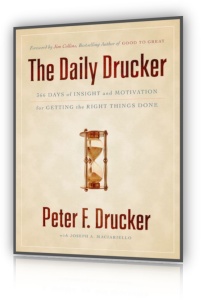
Amazon link: The Daily Drucker: 366 Days of Insight and Motivation for Getting the Right Things Done
NBC Universal's Jeff Zucker says he's being shown the door
Comcast's Steve Burke told him to 'move on' after the merger.
Jeff Zucker, a lifelong employee of NBC Universal, said Friday that he would step down as chief executive after being told there won't be a place for him once Philadelphia cable giant Comcast Corp. takes over the company at the end of the year.
Now, for the rest of the story …
Soros to return outsiders' hedge fund money
(Reuters)—Billionaire investor George Soros, whose stock-picking career has spanned nearly four decades, said he will manage money only for himself and his family as new regulations threaten to crimp the hedge fund industry he made famous.
The octogenarian fund manager, known as much for earning $1 billion on a nervy currency bet as for giving away millions to support liberal causes, will return roughly $1 billion to outside investors most likely by the end of the year and turn Soros Fund Management into a family office. The sum represents only a small portion of the $25 billion he oversees.
Keith Anderson, who has been Soros' chief investment officer since 2008, will leave the firm.
Now, for the rest of the story …
Soros hires new chief investment officer
(Reuters)—Billionaire investor George Soros is continuing to overhaul the management team of his Soros Fund Management LLC, which is converting from a hedge fund to a family office.
The octogenarian fund manager, who is in the process of returning $1 billion to outside investors, announced in a September 19 letter that Scott Bessent is joining as the firm's new chief investment officer.
Bessent, a former Soros fund alum, most recently was a senior partner and director of research for Protege Partners. He will takeover for Keith Anderson, who stepped down as the fund's chief investment officer in July.
Now, for the rest of the story …
What are the opportunities time and history have (will) put within your grasp? — Peter Drucker
What do you want to be remembered for? may be the ultimate objective.
The remaining parts of life design
Life design is both a verb and a noun. Life design action (verb) creates life design (the noun). This is a process that should continue through out life until you are no longer mentally capable of doing it. If you don't find out what is desirable for you, how can to navigate?
Why would we be concerned with life design—isn't it obvious?
Isn't life design about having more stuff? Isn't it about having it all?
 Look at the number of rich and famous who seem to have it all and note how many live seriously "troubled" lives. Who in their right mind would create such a design? Look at the number of rich and famous who seem to have it all and note how many live seriously "troubled" lives. Who in their right mind would create such a design?
How many people do you know or observe who really enjoy life? How many wear this enjoyment on their face?
When people have a crisis in their lives—a death of someone close to them; the loss of a job which they held for a long time—they very often discover that what they thought was their life has evaporated. Do we then over-react?
How many live a life worth remembering?
Is a busy life a worthy life?
Trading lives: When we pay for something we are exchanging the time we spent to acquire the purchasing power for someone else's idea of how we should be spending our lives. This may be constructive or not. If it is constructive, then the price should be questioned.
Unconscious time demands: Time is a limiting factor and a limited resource. Often unconscious time demands accompany the initial target of our desires and designs. For example, buying a large yard entails large yard maintenance and larger property taxes which reduces the time and money for other desires and designs. The more stuff in our homes, the more dusting is required. Buying a new car may mean worrying about having it scratched. And so forth ...
Why a blueprint?
A blueprint gives us something concrete to test and modify until it is adequate to what we desire. It could be tested against the issues raised in the previous section.
Working on life design should be "fun"
It gives us something to anticipate.
It is the opposite of just waiting around to die.
It should keep something mouth wateringly delicious on our brains.
If we never consciously work on this (with a realistic and informed foundation), we deprive ourselves of something substantial—a life we can call our own.

Life design concept map
The image below is a life design concept map with three major dimensions.
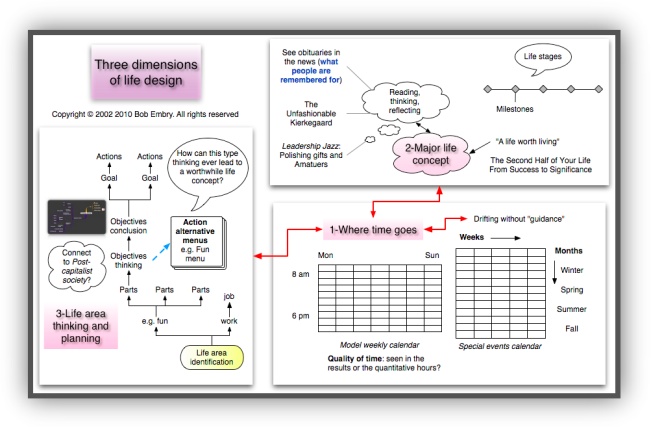
Larger view
The concept map has three dimensions:
 Dimension 2: Life viewed as a whole—sometimes within life stages (major situations) Dimension 2: Life viewed as a whole—sometimes within life stages (major situations)
 Dimension 3: Life viewed as areas (life in society: work; fun; relationships; health etc. and life in the spirit). Each area has its own objectives, goals, activities and actions. Dimension 3: Life viewed as areas (life in society: work; fun; relationships; health etc. and life in the spirit). Each area has its own objectives, goals, activities and actions.
 Dimension 1: Where time goes (how we spend our time) Dimension 1: Where time goes (how we spend our time)
These dimensions occur along our Life Lines
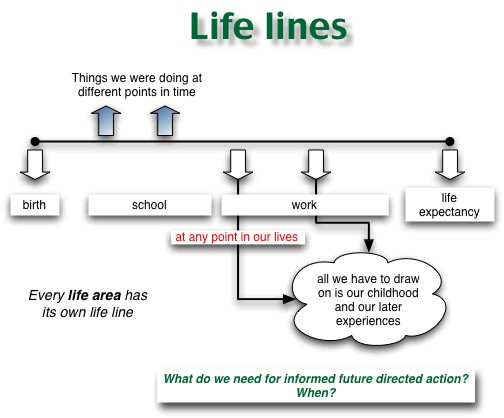
Our life lines are embedded in the changing social and economic picture
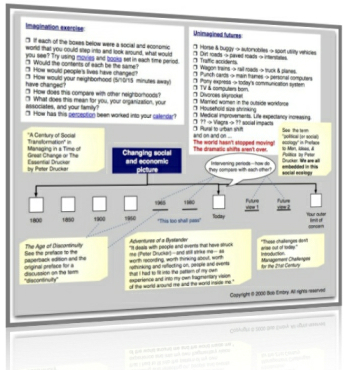
Something is driving the changing world
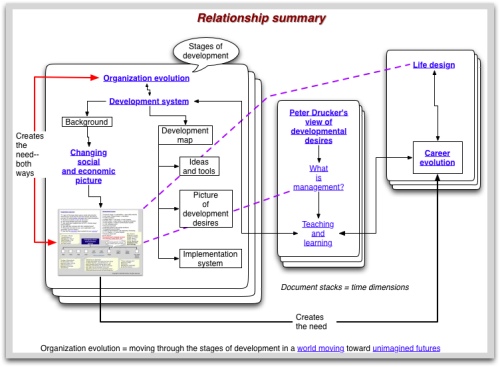
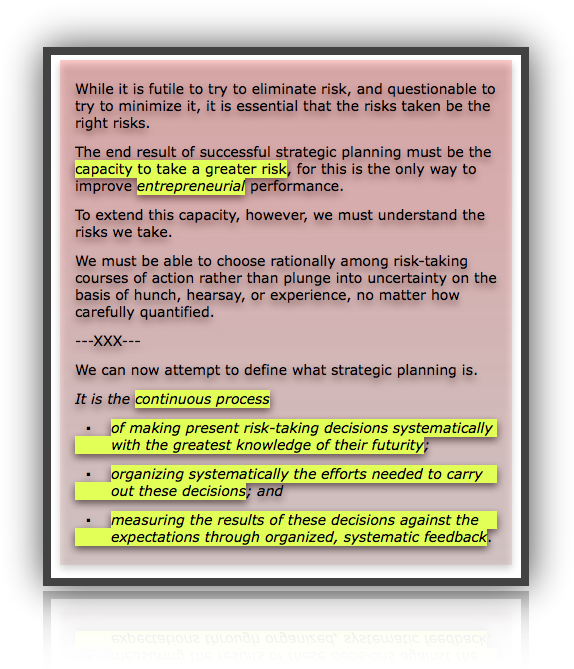
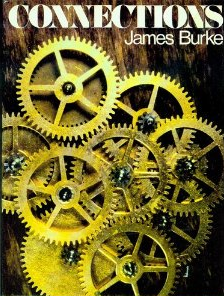 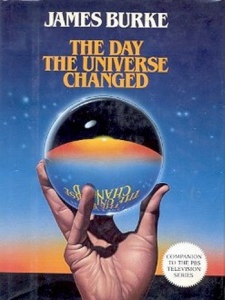 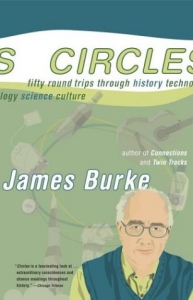
Amazon links:
Connections
The Day the Universe Changed
Circles: Fifty Round Trips Through History Technology Science Culture
The Personal Time Dimension
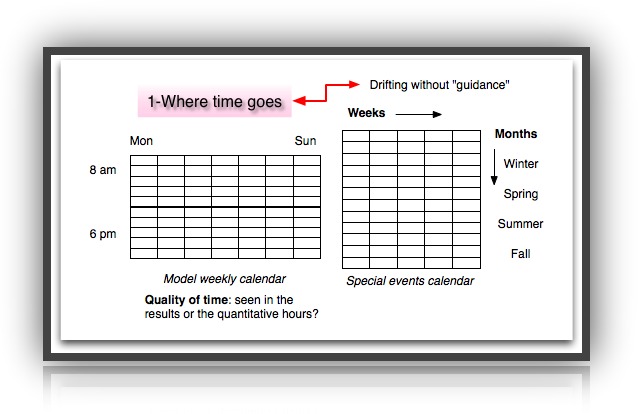
Life happens in time. We can spend our time spontaneously as ideas come to us either by the flow of events or on a whim. This could be viewed as living without a guidance system. An alternative might be to design some model calendars for how we want to spend our time.
Find "Know thy time" in The Effective Executive
Time can also be directed by the two types of guidance systems introduced below.
The Life Area Dimension
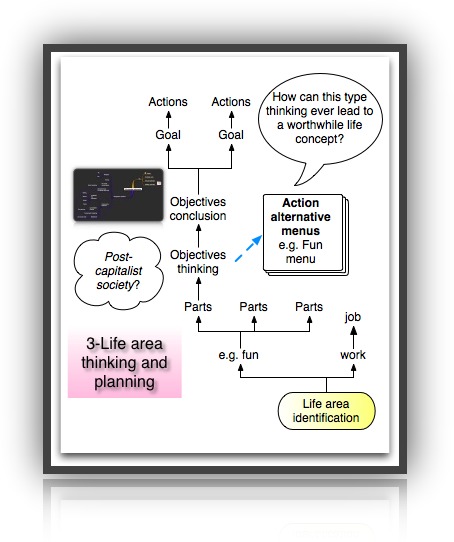
We can try to identify important areas or roles in human life and develop objectives, goals, and actions. The mental pattern danger lurks here. And the question of maximization vs. optimization also lurks here. What are the right goals? Seriously evil people have dreams and goals. Hitler, Stalin, and Mao had goals. People at various points in time have goals and dreams. How did work out?
 Fun system Fun system
 Living in More Than One World Living in More Than One World
 The Power of an Hour (may be dangerous—an alternative view in one time dimension. Contrast with Teach Yourself How To Think) The Power of an Hour (may be dangerous—an alternative view in one time dimension. Contrast with Teach Yourself How To Think)
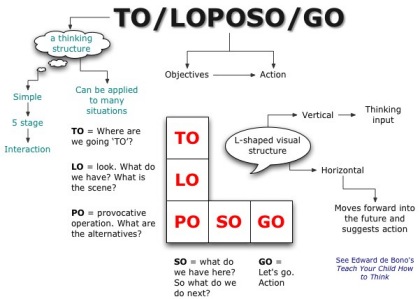
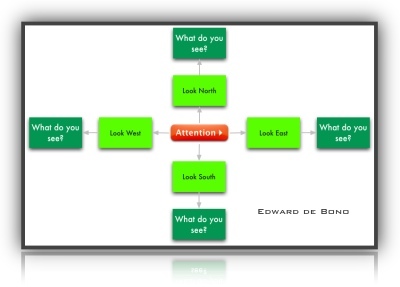
 Non-competitive life Non-competitive life
The ideas we develop rest on our assumptions about the nature of the world in which we are embedded. See Post-Capitalist Society.
Parents are advised to look at their assumptions pertaining to their children's education. See The Educated Person and my delicious bookmarks
We can also identify important desirable elements in our lives—see image below. Obviously some of these desirable elements are dependant upon what's available in the outside world—what's available is connected to organization evolution and career evolution. Both organization and career evolution are time dependent. Having an iPhone in 1980 was not possible.
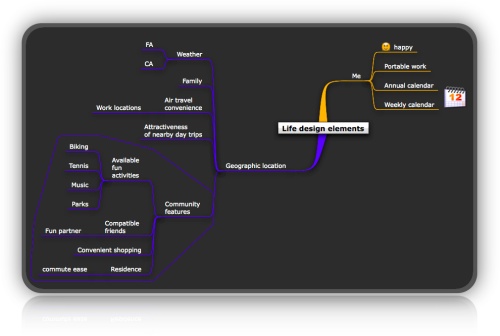
Larger view
Collecting images of areas of attraction can help identify the magnets in our lives

The Whole Life Dimension
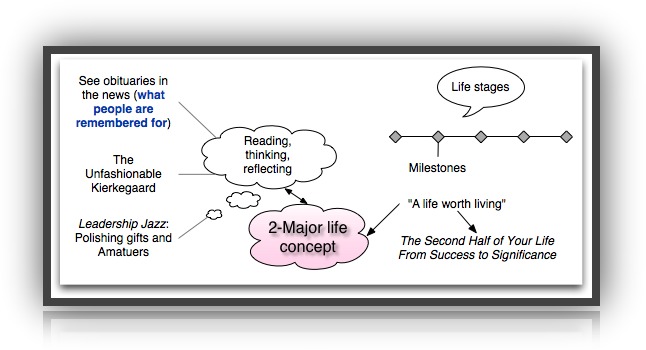
The other form of guided time usage involves having a whole life concept. Below are some suggested readings:
 Nine American Lifestyles Nine American Lifestyles
 What people are remembered for. Obituaries in the news can be read daily with the help of a RSS feed and a news aggregator (Google Reader). What people are remembered for. Obituaries in the news can be read daily with the help of a RSS feed and a news aggregator (Google Reader).
 The Unfashionable Kierkegaard (A chapter from The Ecological Vision: Reflections on the American Condition The Unfashionable Kierkegaard (A chapter from The Ecological Vision: Reflections on the American Condition by Peter Drucker) by Peter Drucker)
 How can the individual survive? How can the individual survive?
 Leadership Jazz: Polishing Gifts and Amateurs Leadership Jazz: Polishing Gifts and Amateurs
 The Second Half of Your Life The Second Half of Your Life
 Handbook For The Positive Revolution Handbook For The Positive Revolution
 Make retirement the better part of your life Make retirement the better part of your life
 The Purpose Driven® Life: What on Earth Am I Here For? The Purpose Driven® Life: What on Earth Am I Here For? (A huge best seller. I haven't read it and don't plan to) (A huge best seller. I haven't read it and don't plan to)
 Happiness Happiness
I once heard a Drucker interview in which he said something like: The happiest, no the most contented, people I know live in more than one world.
 Adventures of a Bystander Adventures of a Bystander
 People behaviors People behaviors
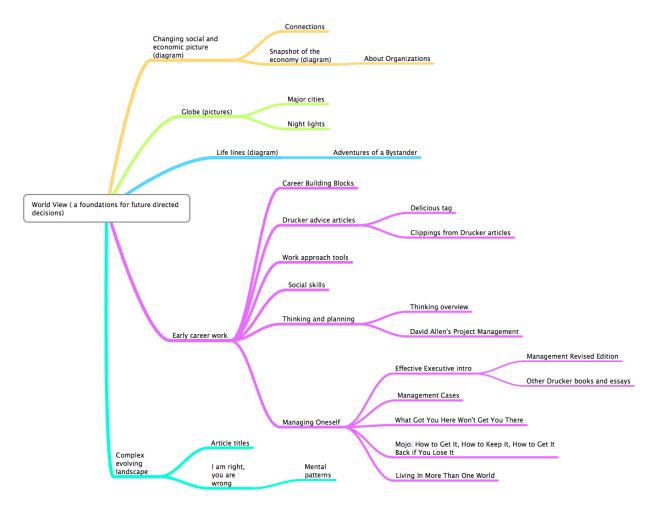
Larger view
Life design brainscape prototype blueprint
The illustration below integrates the life design concept map; a strategic work plan for calendarizing areas for time investment; and a process for harvesting action ideas from specific information or conceptual resources.
The basic approach is to identify areas of interest, sequence them, and go to work. The ideas in the life management system suggests some mechanical approaches and tools.
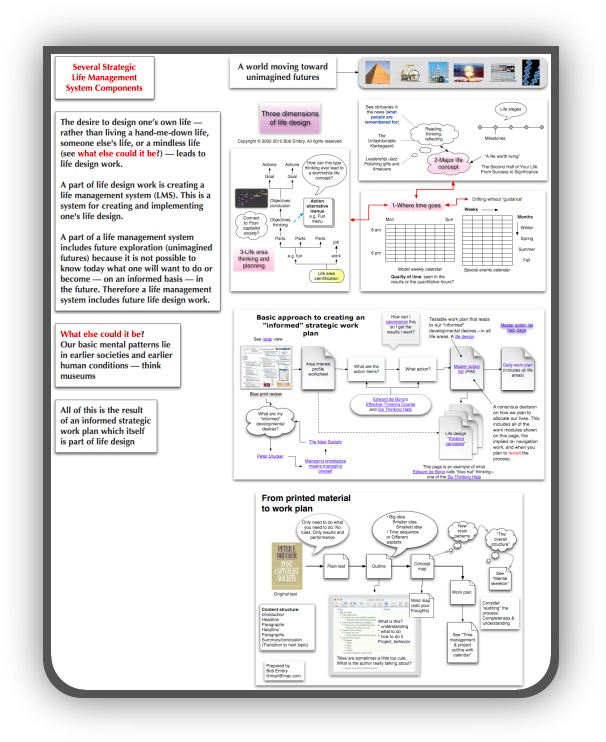
Larger view
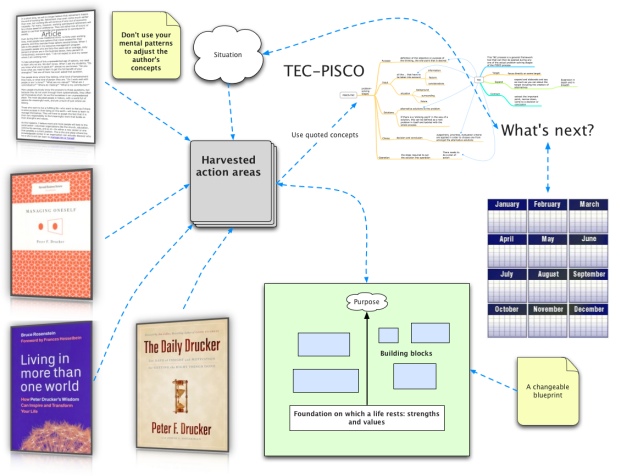
Larger view
Career and Life Guidance from Peter Drucker
is attention-directing work
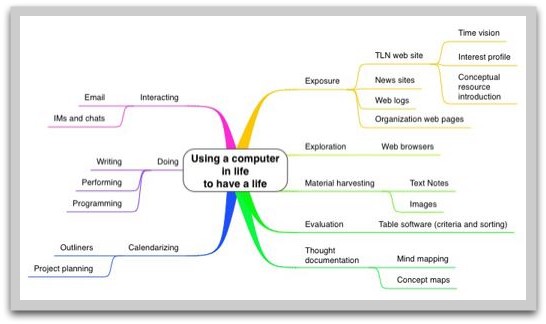
Related:
Concepts to daily action (prototype processes for harvesting ideas from conceptual resources and using them to help design your future life and liveS)
Thinking canvases (ways of visualizing information and designing action)
Teach Yourself to Think
The Six Value Medals (thinking about importance)
Six Frames For Thinking about Information
David Allen's GTD system
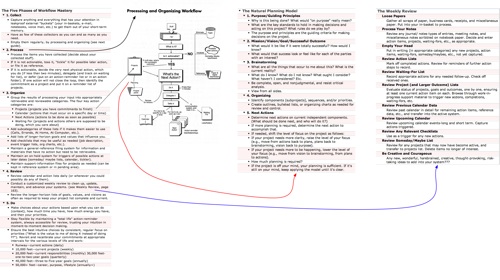
Larger view
What's next
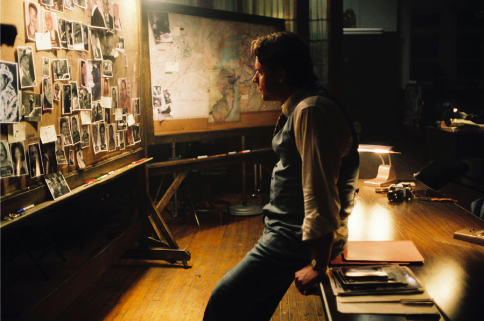
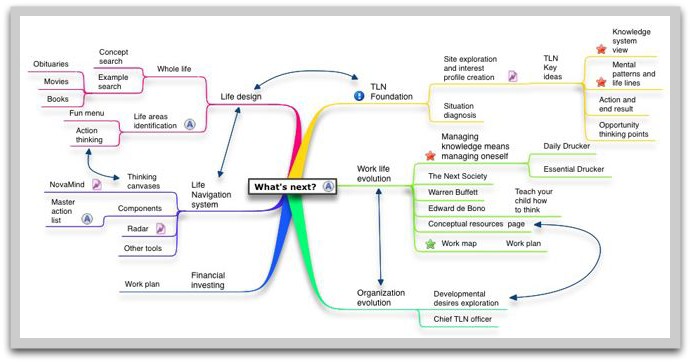
Bottom line?
"What do I have to DO (informed in each of the five time-life navigation dimensions—illustration) so I have the kind of life (informed) I want (informed) in a world with other people that interact through complex systems?"
Imagine the different kinds of answers a person 10, 15, 20, 25, 35, 45, 55, 65, 75, or 85 years old would have.
What about the differences between being informed and uninformed?
How would answers vary between 1900, 1925, 1930, 1935, 1945, 1960, 1980, 1990, 2005 or 2020?
So it should be obvious that different combinations of age, points in time, and levels of informedness lead to different answers.
Add in geographic location differences and there are more different actions.
With this in mind, what is the appropriate action? Or maybe what are the elements of the appropriate action?
Creating and maintaining life design mind maps or thinking canvases may be helpful in keeping something genuinely interesting and meaningful on the road ahead of you. (calendarize this)
… People change over such a long time span. They become different persons with different needs, different abilities, different perspectives, and, therefore, with a need to "reinvent themselves" for the second half of their lives.
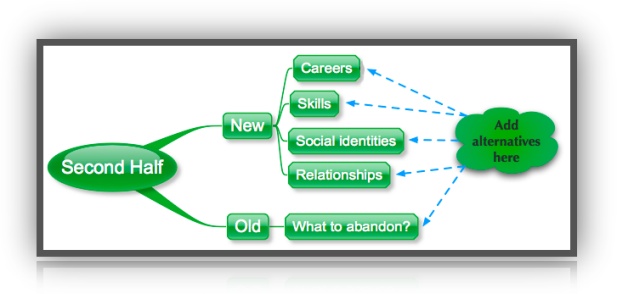
Ten Principles for Life II
Personal opportunity
Every thing on this page is potential INPUT to a model calendar system for designing your life and time usage
IS THAT ALL THERE IS?
by Peggy Lee on iTunes
SPOKEN:
I remember when I was a very little girl, our house caught on fire.
I’ll never forget the look on my father’s face as he gathered me up
in his arms and raced through the burning building out to the pavement.
I stood there shivering in my pajamas and watched the whole world go up in flames.
And when it was all over I said to myself, “Is that all there is to a fire”
SUNG:
Is that all there is, is that all there is
If that’s all there is my friends, then let’s keep dancing
Let’s break out the booze and have a ball
If that’s all there is
SPOKEN:
And when I was 12 years old, my father took me to a circus, the greatest show on earth.
There were clowns and elephants and dancing bears.
And a beautiful lady in pink tights flew high above our heads.
And so I sat there watching the marvelous spectacle.
I had the feeling that something was missing.
I don’t know what, but when it was over,
I said to myself, “is that all there is to a circus?”
SUNG:
Is that all there is, is that all there is
If that’s all there is my friends, then let’s keep dancing
Let’s break out the booze and have a ball
If that’s all there is
SPOKEN:
Then I fell in love, head over heels in love, with the most wonderful boy in the world.
We would take long walks by the river or just sit for hours gazing into each other’s eyes.
We were so very much in love.
Then one day he went away and I thought I’d die, but I didn’t,
and when I didn’t I said to myself, “is that all there is to love?”
SUNG:
Is that all there is, is that all there is
If that’s all there is my friends, then let’s keep dancing
SPOKEN:
I know what you must be saying to yourselves,
if that’s the way she feels about it why doesn’t she just end it all?
Oh, no, not me. I’m in no hurry for that final disappointment,
for I know just as well as I’m standing here talking to you,
when that final moment comes and I’m breathing my last breath, I’ll be saying to myself
SUNG:
Is that all there is, is that all there is
If that’s all there is my friends, then let’s keep dancing
Let’s break out the booze and have a ball
If that’s all there is
TLN Keywords: tlnkwlifedesign
|
![]()
